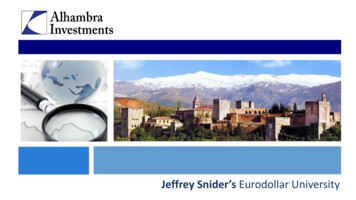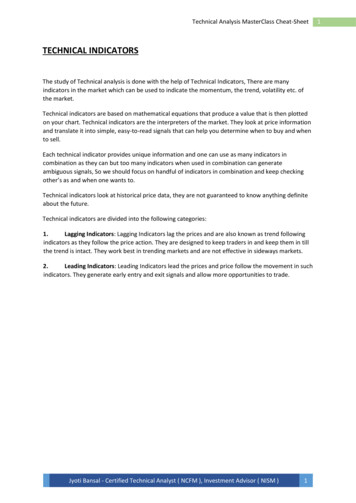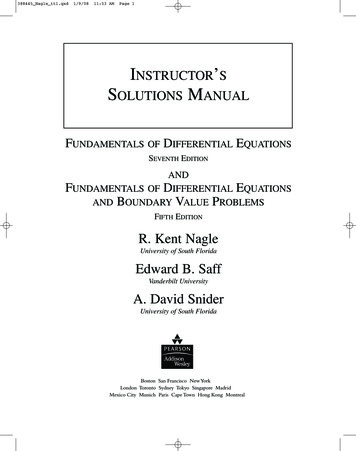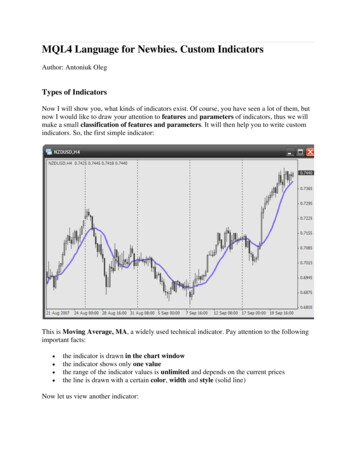
Transcription
Financial market indicators of global liquidity risksby Jeffrey P. Snider1June 15, 2019AbstractUncertainty in US trade policy has coincided with but remains an insufficientexplanation for the global economic slowdown since early 2018, which is only one ofseveral such trade cycles since the Great Financial Crisis. Global liquidity conditions,particularly offshore dollar liquidity, remain a critical but obscure driver of these tradecycles. This paper’s contribution to existing literature is the use of TreasuryInternational Capital (TIC) data as an additional proxy for these global liquidityconditions. Additionally, I identify a set of financial market indicators that reflectfinancial intermediaries’ perception of liquidity risks and demonstrate a closecorrelation with trade cycles.JEL Classification: TBDKeywords: TBD1Head of Global Research, Alhambra InvestmentsThe author wishes to thank Bryce Albin, Emil Kalinowski, and one other for their very valuable comments,insightful suggestions and contributions.
1 IntroductionGeneral worldwide consensus in late 2016 and throughout 2017 was that theglobal economy as a whole had finally reached a critical stage from which it couldshake off any lingering effects of the Great Financial Crisis (GFC). Termed “globallysynchronized growth”, policymakers began to shift their thinking toward an inflationaryenvelope; ending nearly a decade of almost constant stimulus policies and replacingthem with those directed toward managing a normalization process.The view largely prevailed through much of 2018. As the year progressed,however, more and more financial markets as well as economic data began to displayclear signs of uncertainty which was wholly inconsistent with acceleration in growthand inflation. Volatility in many markets erupted as last year came to a close. Of moreconcern, the same uncertainty continues to linger, as does volatility, nearly halfwaythrough 2019.The coincident timing of a rise in trade protectionism has formed the basis ofmany if not most mainstream explanations. In specific terms, the US imposing tariffson Chinese goods and China’s response to those restrictions only amount to relativelysmall changes balanced against all of global trade. Attempting to make up thedifference, to try and explain very clear and significant downside risks materializing ineconomies all over the world, economists have been left studying the potentialchannels of second and third order effects of “trade war” sentiment more broadly.Rather than seeking to assign uncertainty to intangible concerns aboutpotentially small, non-specific threats, we can look to financial markets for clues as toother alternative factors. In them, uncertainty is equivalent to “flight to safety”, theunusual and significant demand for highly liquid, low risk securities.Analyzing the behavior of sovereign bond yields, particularly those in the UnitedStates (US Treasuries), there is an unmistakable pattern which in the short run focusesour attention first on May 29, 2018. In the longer-term, we observe how this kind offlight to safety isn’t a new development, nor has it been unusual for the last decade.We observe repeating periods when flight to safety becomes establishedacross a whole range of market and data points. Since 2009, there have been two ofthese “cycles” (2011-12, 2014-16) fully completed (not including the outlines ofperhaps a minor, incomplete fluctuation in 2010) with a third (2018-) currentlyunderway.The nature of these market oscillations is consistent in each one [Table 1].Putting them together with other indications (TIC, swap spreads) pointing in thedirection of a shadow structural defect in global dollar funding markets, flight to safetygoing back to 2007 has become synonymous with recurrent flight to liquidity.2
With regard to last May, in the minutes published for its July/August 2018 policymeeting, the Federal Reserve’s policymaking body suggested a puzzle in the globalbond markets. Forecasting wage-driven inflation from full employment and theeconomic acceleration accompanying it, the FOMC had been in the midst of a policytightening cycle. All these factors together should have produced higher nominalinterest rates not just in US dollar markets but all over the world (globally synchronizedgrowth).In between May 17 and May 29, 2018, yields suddenly and precipitouslydeclined (not just in US bond markets). The benchmark 10-year US Treasury bondyield was 3.11% on May 17 falling to 2.77% on May 29; the rate dropping 16 bps onMay 29 alone. In the wake of this contrary behavior, along with the sharply flatteningyield curve, the FOMC in late July/early August struggled to explain the occurrence.The text cited two factors: central bank bond purchases as well as “the strongworldwide demand for safe assets.” 2 The first could potentially be reconciled as amatter of policy support (in other jurisdictions). The second could not; the minutessuggest policymakers were left to imply that the long end of the bond curve(s) inparticular was perhaps mispricing conditions.In the wake of May 29, 2018, however, though nominal yields did eventuallyrise again into October, economic uncertainty has continued to increase the worldover. Subsequently, bond yields have fallen sharply in the months since lastNovember.Primarily, “safe assets” are in demand largely due to perceived liquidity risksamong global financial participants. This asset class is characterized by the mostfavorable liquidity characteristics, which include use in repo markets as “pristinecollateral.”Thus, in terms of yield curve analysis, financial market participants might reactto rising liquidity risks by hedging and buying in UST’s, UST futures, eurodollar futures,2Minutes of the Federal Open Market Committee, July 31-August 1, 2018. During participants’ discussion of theflattening yield curve, the Committee began to contemplate the possibility of inversion and at the time saw noreason why that would be an appropriate response in the Treasury market given the FOMC’s projections andinterpretations of conditions.3
interest rate swaps, etc. This would propose a very different market-based view ofinflation expectations as well as the projected path of short-term interest rates andtherefore provide us with an answer for uncertainty unrelated to “trade wars.”What’s left are only the possible reasons for these perceptions, starting withliquidity risks. Conventional theory suggests that after several rounds of quantitativeeasing (ending in October 2014) the US central bank had increased the level of bankreserves to a sufficient position. In this view, liquidity risks should be minimal therebyleaving only (negative) term premia to answer for (persistently) lower bond yields.If, however, quantitative easing and the byproduct of bank reserves were aninsufficient technical monetary policy response to system requirements for effectiveliquidity (money, more broadly), global bond yields in 2018 and 2019 would fall underthe characterization of Milton Friedman’s interest rate fallacy: persistently low ratesadvise of effectively tight money conditions in the real economy. 3A US dollar liquidity channel centered apart from US bank reserves wouldfurther propose a more closely linked global system, one of interwoven, tightlyconnected financial/money participants located all throughout the world. It would alsopresent the possibility that it operates outside of traditionally defined boundaries, notjust geography, and therefore presents an answer to central bank bond market andinterest rate puzzles as well as provide a more comprehensive and consistentexplanation for recent uncertainty, volatility, and global liquidity risk.This paper is organized as follows: Section 2 provides a brief conceptualbackground and a survey of relevant literature on global liquidity, along with existingempirical measures. Section 3 describes a set of financial market indicators that reflectliquidity risks and are correlated with trade cycles. Section 4 concludes with asummary of key findings and proposed extensions in this research area.2 Conceptual overview and empirical measures of global liquidityconditionsConceptual overview and existing literature on global liquidityThe importance of US dollar liquidity is oftentimes understated or obscured.The functions of a global reserve currency are paramount to the health andmaintenance of worldwide economic expansion. The scale of what is required from it,or at least what had built up of it, indicates its essential nature. A global reservecurrency, by definition, has to be reasonably and efficiently accessible in all parts ofthe world.3Economist Milton Friedman had first discussed the “interest rate fallacy” as far back as December 1967 in hisremarks to the 80th Annual Meeting of the American Economic Association. He more famously reasserted thefalse impression of interest rates in 1997, recounted as a Hoover Institute research piece in April 1998 as follows:“After the U.S. experience during the Great Depression, and after inflation and rising interest rates in the 1970sand disinflation and falling interest rates in the 1980s, I thought the fallacy of identifying tight money with highinterest rates and easy money with low interest rates was dead. Apparently, old fallacies never die.”4
The GFC beginning in 2007 acted as something like a particle collider whichphysicists use as a tool to peer into the hidden world of matter and energy. The panicwhich resulted, the great strain of liquidity upon financial markets applied sufficientpressure and energy to begin breaking open the cover of what had been at best anopaque operation. In the breakdown of especially interbank spaces, it gave interestedobservers the chance to begin piecing together a more detailed picture of what hadbeen taken for granted for many years beforehand.In October 2009, Patrick McGuire and Goetz von Peter (McGuire and von Peter2009) estimated that, “The origins of the US dollar shortage during the crisis are linkedto the expansion since 2000 in banks’ international balance sheets” and that the scaleof these international obligations had increased from 10 trillion at the beginning of2000 to 34 trillion by the onset of the emergency.They also estimated that a synthetic dollar short or funding requirement hademerged, a mismatch between generally longer-term US dollar assets and shorterterm even ultra short-term US dollar liabilities on the scale of 2 trillion to perhaps asmuch as 6.5 trillion. The functions of this dollar short were provided by these sameinternational financial intermediaries, not all of which were banking entities (nonbankssuch as money market funds were common participants). Operating in internationalcapacities, the system was effectively offshore.In response to a growing global financial crisis, the Federal Reserve onDecember 12, 2007, announced reciprocal dollar arrangements (currency swaps) withthe European Central Bank, Bank of England, Swiss National Bank, and Bank ofCanada. Along with TAF auctions, these were early “measures designed to addresselevated pressures in short-term funding markets.” 4By December 2008, the list of eligible central bank counterparties had beenexpanded and the aggregate amount drawn on them had reached more than 580billion. 5 This indicated, very plainly, the serious, crisis demand for dollars originatingfrom outside the US geographical boundary. Banks and financial counterpartiesdomiciled elsewhere were left with no other options than to try to obtain alternate dollarsources.Conventionally, the Great Financial Crisis of 2008 has been explained as aconsequence of unbridled risk-taking. Banks especially during the late nineties andmiddle 2000’s took on leverage and invested in increasingly poor-quality assets(subprime mortgages). This does not explain how or why during the worst panic of thelast four generations there came to be such massive demand for dollars offshore thatno market participant was either willing or able to supply.Take, for example, the emergence and persistence of an unusual LIBORspread [Figure 2-1]. On August 9, 2007, this interbank offshore dollar rate rose sharply.Initially, the interest rate for federal funds did, too. On August 10, however, the tworates would diverge and stay that way for much of the rest of the crisis.4Federal Reserve press release dated December 12, 2007.Federal Reserve, H.4.1 "Factors Affecting Reserve Balances of Depository Institutions and Condition Statementof Federal Reserve Banks.”55
To put it in oversimplified and literal terms, there was “too much” money indomestic federal funds and a clear shortage of it in offshore interbank places. Abreakdown of transmission in both policy (traditional measures of “accommodation”and new liquidity practices like dollar swaps invented during the GFC) as well asstandard private monetary practice.In response to what eventually amounted to a full-blown worldwide financialpanic, central banks - particularly the US Federal Reserve - began to engage in largescale asset purchases (LSAP). The primary accounting byproduct of these rounds ofquantitative easing (QE) was a large increase in outstanding US dollar bank reserves.These are characterized in standard literature as a form of base money.Despite the introduction of LSAPs/QE and the increase in bank reserves, wehave observed successive discrete periods of what can only be described asinsufficient liquidity; a global dollar shortage renewed at specific occasions. Spreadstend to worsen, the dollar tends to rise in exchange value, and the strong worldwidedemand for safe assets rematerializes.By 2010, the first “minor fluctuation”, there were already signs of reintroducedsevere liquidity problems showing up in much the same places as before. In 2011, itbecame a second global liquidity crisis which swept over the system.The Federal Reserve had already responded in November 2010 with a secondround of QE. The level of bank reserves was increased further, and yet by the summerof 2011 FOMC officials were confronted by stark evidence for the ineffectiveness ofthose programs. On August 9, 2011, then-Open Market Operations Manager BrianSack realized:6
“We are seeing a lot more discussion about the potential need forliquidity facilities. I mentioned in my briefing that the FX swap lines could beused, but we’ve seen discussions of TAF-type facilities in market write-ups. Sothe liquidity pressures are pretty substantial. And I think it’s worth pointing outthat this is all happening with 1.6 trillion of reserves in the system.” 6The week before, Chairman Ben Bernanke had to confront the possibility thatthis system was in many ways detached from the central bank’s area of responsibility.“I think a point that was somewhat underemphasized is that our transmission ofmonetary policy is an issue here as well. So to take an example, doing repos to keepthe RP rate from uncoupling from the federal funds rate, arguably there are issuesthere relating to transmission.” 7As I document in Section 3, these same repo issues have continued to persistwith the appearance of these almost regular liquidity cycles regardless of the level ofbank reserves.Beyond the monetary and financial realms, global economic output is curtailedfirst in those economic sectors most sensitive to money and credit: global trade andglobal capital investment.The GFC is very well defined, so my focus in this paper is on these ensuingperiods of monetary uncertainty which are only slightly less clear. What we observe isthe repeated breakdown in money market hierarchy, an imbalance beyond monetarypolicy transmission indicating the potential for serious even severe strain in worldwidedollar conditions.While, again, the conventional explanation for 2008 has focused on subprimemortgages and occasionally shadow banking, the massive monetary dislocation of2007-09 was as much a global dollar disruption which spread liquidity fears all overthe world. Subsequent scholarship has more and more pointed in the direction of whatmight amount to shadow money at least starting in the form of interbank liquidity.In May 2017, Hyun Song Shin (Shin 2017) noted how, “Behind the financialchannel of exchange rates is a dense matrix of financial claims in dollars. The globaleconomy is a matrix, not a collection of islands, and the matrix does not respectgeography.” In September 2017, Claudio Borio, Robert Neil McCauley, and PatrickMcGuire (Borio, McCauley, and McGuire 2017) found:“Every day, trillions of dollars are borrowed and lent in variouscurrencies. Many deals take place in the cash market, through loans andsecurities. But foreign exchange (FX) derivatives, mainly FX swaps,currency swaps and the closely related forwards, also create debt-likeobligations. For the US dollar alone, contracts worth tens of trillions ofdollars stand open and trillions change hands daily. And yet one cannot findthese amounts on balance sheets. This debt is, in effect, missing.”67Transcript of the Meeting of the Federal Open Market Committee on August 9, 2011.Transcript of the Conference Call of the Federal Open Market Committee on August 1, 2011.7
The complications for liquidity and its flow extend in multiple directions. In repomarkets, for example, there is always the potential for collateral pressures. Caballero,Farhi, and Gourinchas (2017) describe several serious issues of what they call a “safeasset shortage.”The collected inference is an external system of liquidity (from the point of viewof not just US monetary authorities, but all monetary authorities as a consequence)that is at the very least not well understood nor very well documented. As it wouldaccount more completely for the breakdown(s) in the GFC, the implications stand asa possible continuing factor; prominent unsolved liquidity risks therefore financialuncertainty and volatility leading to ongoing global economic risk and restrainedinvestment and growth.In particular, the potential for higher costs or the inability of economic agents toreasonably and efficiently source these global dollars as required of a global reservecurrency system would act as a drag and an impediment first through global trade[Figure 2-2] and then through capital flows particularly related to capital intensiveinvestment.Hyun Song Shin (Shin 2019) talks about the relevant research of Global ValueChains (GVC):“Building and sustaining GVCs are highly finance-intensive activities thatmake heavy demands on the working capital resources of firms. When thefinancial requirements go beyond the firm’s own resources, the necessaryworking capital is dependent on short-term bank credit. The financingrequirement for GVCs arises because firms need to carry inventories ofintermediate goods or carry accounts receivable on their balance sheet whenselling to other firms along the supply chain.”The required financed capital is most often denominated in US dollars, theglobal reserve, supplied by this offshore shadow network of highly interrelated globalfinancial firms. As in any basic economic circumstance, confronted by liquidity fearsand uncertainty, liquidity suppliers will respond by pulling back what they offer (supply)which has the effect of raising the price of reserve money on the whole in very broadterms.That transmits as feedback back into the monetary system as well as forwardout into the real economy. It can become a self-reinforcing vicious cycle wherebyliquidity fears lead to real constraints on global trade which reduce economic outputmore broadly and therefore confirming the concerns behind uncertainty. Avdjiev,Berger, and Shin (2018) found substantial links between the prior buildup ofinternational credit financed by short-term interbank lending and the macroeconomicimplications using the 1997 Asian financial crisis as an analog.8
Given this monetary channel, I start by noting discrete periods of well-definednegative pressures on global trade. These coincide, as shown in the next section, withthe same periods when we observe monetary irregularities and with flight tosafety/uncertainty.The US dollar exchange rate tends to rise during them, too [Figure 2-3]. Thereis a robust volume of literature documenting the apparent links between a rising dollarexchange value, financial uncertainty or upset, and the negative economicconsequences that often follow. Valentina Bruno and Hyun Song Shin (Bruno andShin 2013) write, “The focus on the US dollar as the currency underpinning globalbanking lends support to studies that have emphasized the US dollar as a bellwetherfor global financial conditions.”Avdjiev et al. (2018) found, “First, there is a strong negative relationshipbetween the US dollar and cross-border bank lending denominated in US dollars.Second, an increase in US dollar denominated cross-border lending to a given EMEis associated with greater real investment in that EME. Finally, a decline in the valueof a country’s currency against the US dollar triggers a decline in real investment inthat country.”9
Empirical proxies of global liquidityIn discontinuing M3 thirteen years ago, the Federal Reserve hinted at one ofthe central problems we face in trying to describe and analyze offshore dollar liquidityconditions. The FRB “judged that the costs of collecting the underlying data andpublishing M3 outweigh the benefits,” suggesting already a high degree of difficulty intracking and estimating the monetary forms in this space. 8Large-denomination time deposits continue to be published in other places, Z1& H.8, while institutional money market fund balances became a regular memo item.The other components of non-M2 M3 which were discontinued entirely were estimatesfor the very things which the GCF placed front and center: repo and, representing thesurface links to offshore dollar funding, eurodollars.Without official definitions and well-sourced data, we are left with incompleteproxies and inference from other data sources as well as market prices. While this isa hindrance for those interested in studying the system, it stands to reason that it is amuch bigger problem for those operating within it.One particularly invaluable proxy is provided by the US Treasury Department.The Treasury International Capital (TIC) series contains a wealth of data includingcompiled activities drawn on a monthly basis from bank call reports of those banks’cross-border dollar transactions. Though this proxy is incomplete, it gives a startingpoint in more traditionally-defined short-term bank liabilities both from US banks to theoffshore world, as well as coming from the offshore world to US banks.8Federal Reserve press release, H.6 Money Stock Measures, dated and released November 10, 2005.10
Domestic banks, from which the Treasury Department solicits the call reports,engage in all manner of cross-border interbank relationships. The data presentedbelow [Figure 2-4] relates to several classes of short-term dollar liabilities. It is a partialreconstruction of potential liquidity volumes available for global liquidity usage.These outbound as well as inbound dollar proxies display rapid growthparticularly in the late nineties and middle 2000’s but only up to March 2008 (BearStearns), and then a very clear and what has proven to be permanent change intrajectory/condition following.The headline or overall TIC figures are consistent with the implications of amore permanent breakdown in offshore dollar liquidity (in the interbank channel)represented above. The series ostensibly measures how much buying and selling ofUS dollar assets is taking place in foreign hands. Put simply, if dollars offshore areexceedingly plentiful for whatever ultimate purposes, it stands to reason foreignerswould have more opportunity and ability to purchase more dollar assets.Consistent with the liquidity thesis, foreigners as reported by TIC tend to buyfar fewer US dollar assets, on net, during these occasions associated with notedliquidity pressures. This has even led to the outright and sustained selling of US dollarassets, on net, in those instances associated with the most strain – including the latestup-to-date data [Figure 2-5].11
We therefore have an outline and a framework from which to begin interpretingthe robust sets of market data pertaining to more visible financial dimensions, factorssuch as bond yields which may contain otherwise hidden liquidity risks embeddedwithin them. Though the TIC figures are far from dispositive, they present to us anintriguing and startling possibility; this idea of an unsolved structural defect whichrather than showing up all at once in one shot during the GFC may continue tointermittently plague a global system therefore the global economy highly dependentupon the behavior of its global reserve (i.e., offshore dollar liquidity).3 Financial market indicators of liquidity riskIn this section, I present evidence first for liquidity problems visible in dollarmarkets. This includes the repo market, cash and collateral, as well as interest rateswaps. These are then translated into market-based signals of inflation expectationsusing TIPS and the expectations for the future path of short-term interest ratessuggested by eurodollar futures. This latter market is also itself a robust indication ofperceptions of liquidity risks.These then form the basis for further interpreting the behavior of US Treasuryyields overall, aligning the constituent parts of them with the data indicating liquidityissues in order to project flight to safety or flight to liquidity within the strong worldwidedemand for safe assets.The accepted Fisherian deconstruction of interest rates decomposes bondyields into three parts: the expected path of short-term interest rates; the expectedlevels of future inflation; and term premiums. In the context of the recent outburst of12
uncertainty, as well as in past episodes, policymakers have especially since the endof US QE viewed lower bond yields as relating to term premiums alone. In 2018 and2019 specifically, mainstream forecasts uniformly called for continued rising US dollarshort rates and higher to significantly higher levels of inflation.This introduces a high degree of bias, assuming first that bond market yieldsare the consistent product of general even specific agreement with mainstreamforecasts. If yields are falling, then policymakers leave only term premiums to answerfor them. They reject other explanations based on the assumption primarilysurrounding bank reserves/QE, leaving them no option to incorporate marketuncertainties in view of alternate cases for effective global liquidity conditions.Uncertainty about mainstream predictions would no doubt affect bothexpectations components, the level of inflation as well as how ambiguity may lead toa variety of outcomes in monetary policy cases. In fact, the two go hand in hand; lessvisibility about the intermediate term and even short run would cloud views on howcentral banks might be able to conduct monetary policy, leaving bond investors tofurther wonder what inflation might be or even could be under those samecircumstances.Faced with more immediate perceptions of heightened liquidity risks across allmarkets, financial participants have historically engaged in this flight to safety activity.As bond markets are forward-looking especially at the longer ends of each yield curve,additional demand for the most liquid securities would reflexively take account of theprospective effects of these negative short run considerations.Therefore, the strong worldwide demand for safe assets is the lynchpinbetween these perceptions about liquidity and the perceived short, intermediate, andlong run consequences which might arise when monetary risks are serious.RepoRepurchase agreements, or repo, are a form of collateralized interbankborrowing. Over the last four decades, the repo market has become the mostprominent form of exchanging the shortest-term liabilities. In the aftermath of the GFC,the repo market has taken on even more operational importance as other short runliquidity/funding formats, unsecured interbank lending, have diminished or evenlargely disappeared.This places enormous weight on its collateral dimensions, including the demandfor securities to be used in obtaining this short run funding. As with any moderninterbank space, complexity is an everyday concern as it pertains to how thesemarkets actually operate. The role of repo in the GFC is well-established (and beyondthe scope of this paper) as it introduced a variation in how collateral is viewed atspecific times.When liquidity is regarded more generally with uncertainty or suspicion, repoparticipants which include not just cash borrowers but also securities lenders (thoseoften engaged in parallel collateral transformation) tend to demand these “pristine”forms of collateral like US Treasury securities as a safeguard or as replacement forsecurities further down the chain which are being re-evaluated as acceptable collateral(and on what terms).13
This added demand for US Treasuries independent of long-range forecastsdescribes an inherent liquidity quality to the securities themselves at all points on theyield curve.Primary dealers positioningPrimary dealers are a technical subset of global money dealer firms. In the US,these are banks or the domestic subsidiaries of foreign banks who deal directly withthe Federal Reserve. Among their primary activities is money dealing, as the termimplies.These include liquidity functions such as the repo market, both as a possiblecash provider as well as a securities lender (including, again, collateraltransformation). It also includes funding of its own activities, meaning cash borrower,using the repo market as its own source of backstop liquidity to fund further dealeractivities down the line.Primary dealers report their positions of the securities they hold to the FederalReserve’s New Y
7kh *)& ehjlqqlqj lq dfwhg dv vrphwklqj olnh d sduwlfoh froolghu zklfk sk\vlflvwv xvh dv d wrro wr shhu lqwr wkh klgghq zruog ri pdwwhu dqg hqhuj\ 7kh sdqlf










